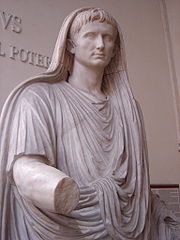
Via Labicana Augustus
Encyclopedia


Roman Emperor
The Roman emperor was the ruler of the Roman State during the imperial period . The Romans had no single term for the office although at any given time, a given title was associated with the emperor...
Augustus
Augustus
Augustus ;23 September 63 BC – 19 August AD 14) is considered the first emperor of the Roman Empire, which he ruled alone from 27 BC until his death in 14 AD.The dates of his rule are contemporary dates; Augustus lived under two calendars, the Roman Republican until 45 BC, and the Julian...
as Pontifex Maximus
Pontifex Maximus
The Pontifex Maximus was the high priest of the College of Pontiffs in ancient Rome. This was the most important position in the ancient Roman religion, open only to patricians until 254 BC, when a plebeian first occupied this post...
, with his head veiled for a sacrifice. The statue is dated as having been made after 12 BC. It was found on slopes of Oppian Hill
Oppian Hill
The Oppian Hill is the southern spur of the Esquiline Hill , one of the famous Seven Hills of Rome. It is separated from the Cispius on the north by the valley of the Subura, and from the Caelian Hill on the south by the valley of the Colosseum...
, in the Via Labicana
Via Labicana
The Via Labicana was an ancient road of Italy, leading east southeast from Rome. It seems possible that the road at first led to Tusculum, that it was then extended to Labici, and later still became a road for through traffic; it may even have superseded the Via Latina as a route to the southeast,...
, in 1910. It is now in the Palazzo Massimo alle Terme at the National Museum of Rome
National Museum of Rome
The National Museum of Rome is a set of museums in Rome, Italy, split among various branches across the city...
.
It is a significant statue because it adds another aspect to Augustus' self-representation; not only is he the political head of the Roman Empire, he is also the religious head of it. In the Res Gestae
Res gestae
Res gestae is a term found in substantive and procedural American jurisprudence and English law. In American substantive law, it refers to the start-to-end period of a felony. In American procedural law, it refers to an exception to the hearsay rule for statements made spontaneously or as part of...
19-21 he talks about all of his religious benefactions to the city of Rome, such as building temples for "Minerva, Queen Juno and Jupiter Libertas."
Augustan representations in statue form are highly controlled to the extent that there are only three (four max.) different subgroups. As with all of Augustus' statues he is depicted in the Greek style of youth as opposed to the traditional Republican representation, which is accurate in its approach.

